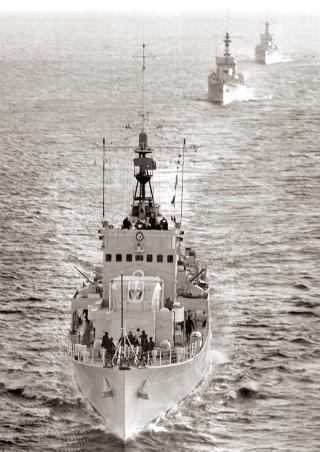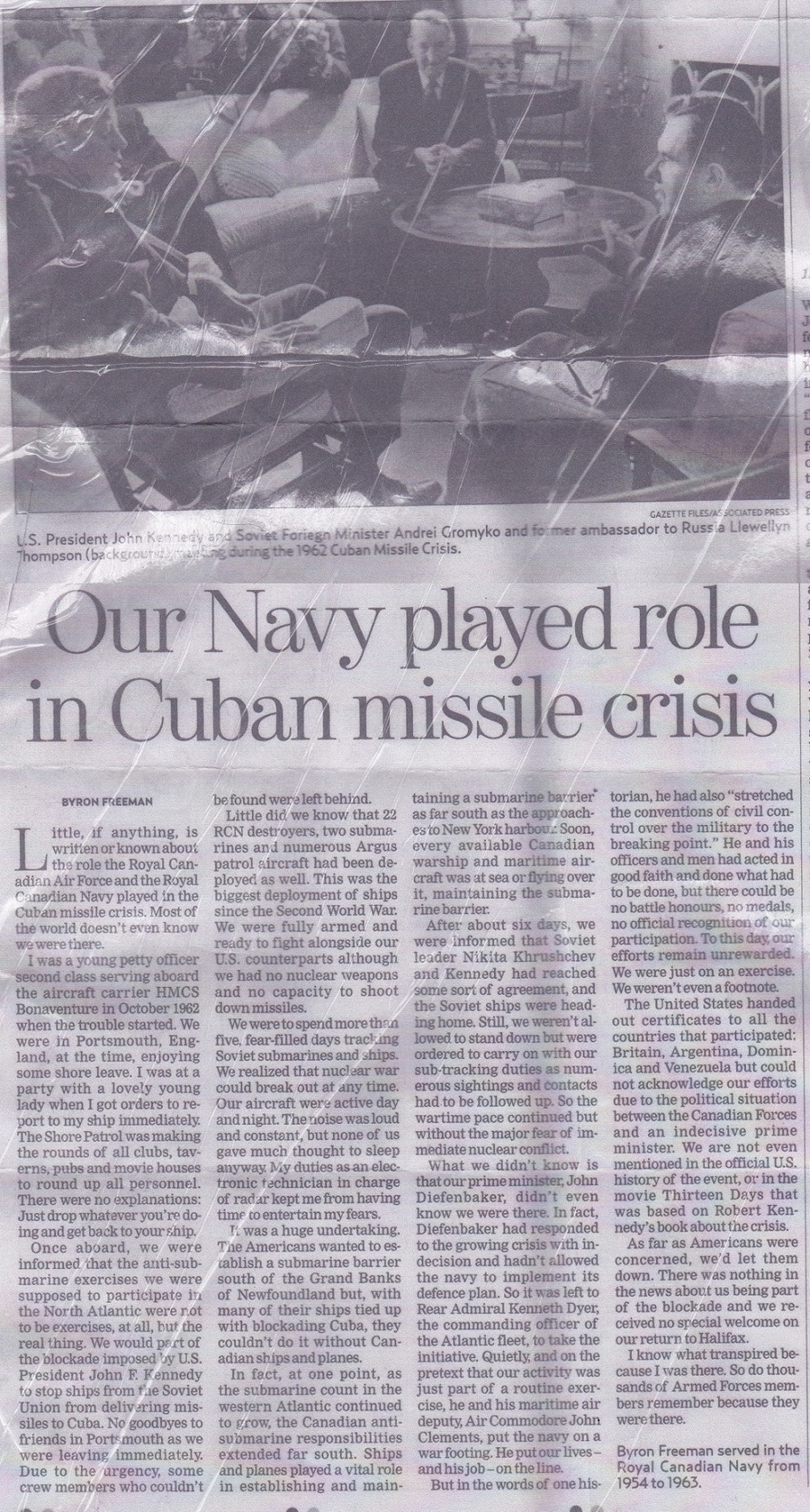|
The Royal Canadian Navy and the Cuban Missile Crisis
Though the RCN's participation in the Cuban Missile Crisis was unofficial - they were still there. The articles on this page provide a brief insight to the RCN's participation in what was a crucial point in the cold war where the world was on the brink of a nuclear disaster.
* Exceptional Circumstances - Canada’s Maritime Response to the Cuban Missile Crisis October-November 1962 by Michael Whitby, Directorate of History and Heritage
* Newspaper article on the RCN's participation in the Cuban Missile Crisis - newspaper unknown
* The RCN and the Cuban missile crisis by Andrew Pye 26 Nov 2009. Source/Credit: Royal United Services Institute of Vancouver Island (RUSI-VI)
* Canadian Involvement in the Cuban Missile Crisis Re-Reconsidered by Peter T. Haydon. Source/Credit: Canadian Nautical Research Society - The Northern Mariner
* The Cuban Missile Crisis 50 Years later - by Peter T. Haydon. Source/Credit: The Canadian Naval Review
Memories of those who were on board RCN ship's during the Cuban Missile Crisis
Submitted by Mo Sabourin, ABFC1, HMCS FRASER 1959-1963
Wish that my memory at 79 years old was more perfect about an incident that happened 57 years ago on my very last cruise on H.M.C.S. Fraser!
I recall very well, that we left "A" Jetty in Esquimalt Harbour at 0800 and slipped out to sea on our scheduled journey to Pearl Harbour where H.M.C.S. Fraser was going to work out with members of the U.S. Navy Pacific Fleet on war and silly training games.
This was to be our very last cruise before the ship was going into its 2nd refit since commissioning and we were all very excited for more shore leave in Honolulu and Waikiki before most of the ships company were to be drafted off the ship!
I had joined the ship in March of 1959 and knew that this was going to be my last time at sea, and I was kind of sad as I stood on the focs'le that morning as bridge telephone talker. I was the senior "Able Seaman" of the focs'le and was very proud of my "OJT's" (on the job trainies just out of boot camp) who had worked hard with me to bring the "pointed end!" up to a very nice looking and clean ship that was more than our work station, it was our home and we were very proud as we let go the "Head Rope!'
A couple hours later we had cleared the light house at Race Rocks, and had turned westward up the Straits of Juan de Fuca, when we heard the pipe, "Do you hear there, this is the Captain speaking!"
We are not going to Pearl Harbour, we will alter course at Cape Flattery, and turn south to enter San Francisco, where I will go ashore, will visit the Canadian Consulate office and receive written further orders as to where the ship will be going to. I have been instructed to open those new ships orders only when we have cleared harbour!
During the same speech, he advised us of the Russian Missiles that had been installed and erected in Cuba, that the US Navy had placed a "Quarantine Ring" around the Island and had asked the Royal Canadian Navy for any and all support!
He closed his "pipe by giving the command, all hands to action stations!
Here is where me memory is failing me, did we close up at action stations at the end of his "Do you hear there" in the straits of Juan de Fuca, or was it shortly after he came back to the ship and opened his orders from San Francisco???
Upon hearing the first Pipe, my first thought was for my wife and young child in Victoria, my goodness I said to myself, they will be in the dark and will not even know where my ship is and if we are alive and well!
After leaving San Francisco, we turned the ship North to Barlay Sound, on the West Coast of Vancouver Island, where we dropped anchor and was met by an RCN Auxiliary Vessel that had brought out six armed and ready homing torpedoes for our ship to use if needed.
I do recall being at "Action Stations" watch on and watch off for about 4 weeks as we cruised the West Coast of North America and scared a whole lot of whales up and down many coastal fiords of the Queen Charlotte Islands. Good thing we had an excellent and well trained crew or we would have targeted a lot of surface and undersea contacts that we were constantly observing.
Needless to say, we had our eyes well trained to find any "Russian Submarines" in our vicinity.
Recall with much happiness the pipe "stand down from action stations" Red Watch on deck!
We were all so very hungry and tired from all that extra effort at our sonar sets, mortars and gunnery divisions, and of course all the other great tradesmen in the engineering and combat, damage control and operations and communications!
It sure was heart warming as we stood on the Focs'le entering harbour and saw our wife and children waving to us from the Jetty, that was a real happy homecoming!
The Royal Canadian Navy frigates HMCS Victoriaville, Inch Arran, and New Waterford of the 7th Canadian Escort Squadron steam in line ahead while on patrol off the east coast of Canada during the Cuban Missile Crisis. Canada’s involvement remains “virtually unknown to this day.” Date: October, 1962 Credit: Naval Museum of Halifax Source: Canadian Virtual Military Museum (on facebook)
Article courtesy of Byron Freeman
|



